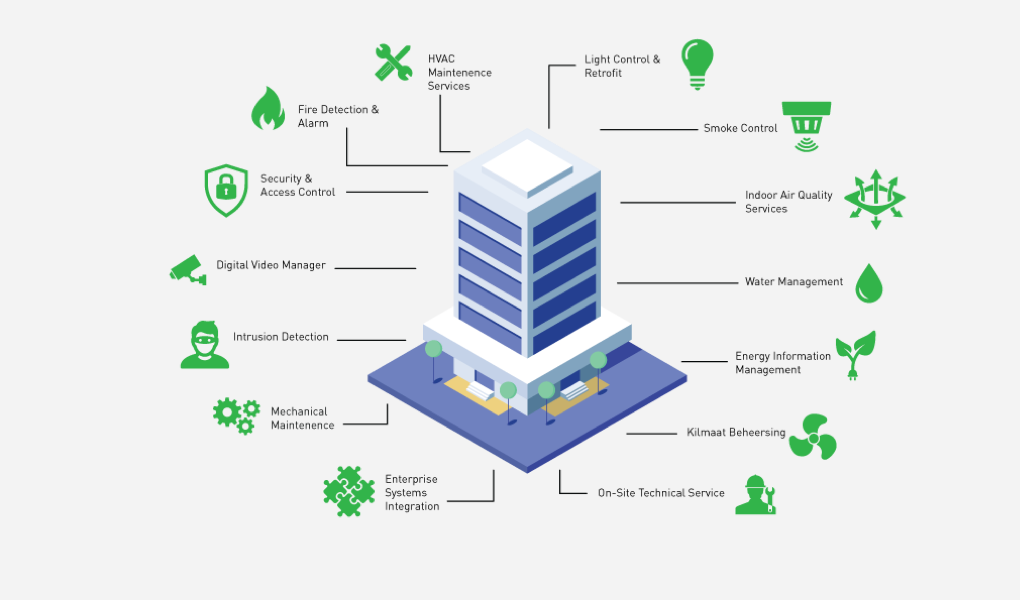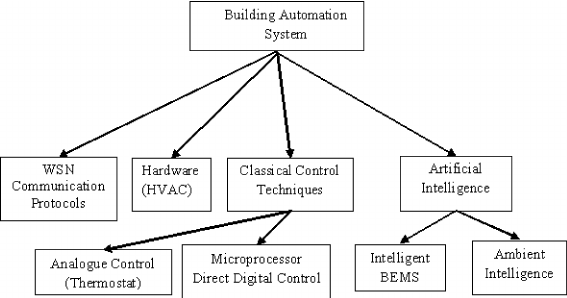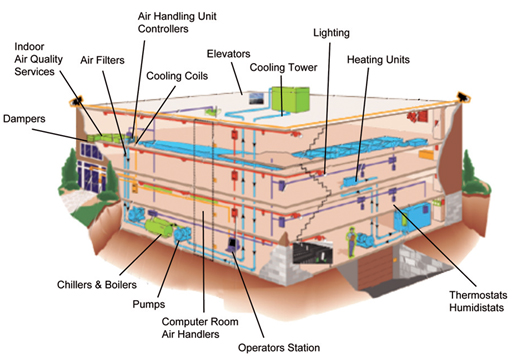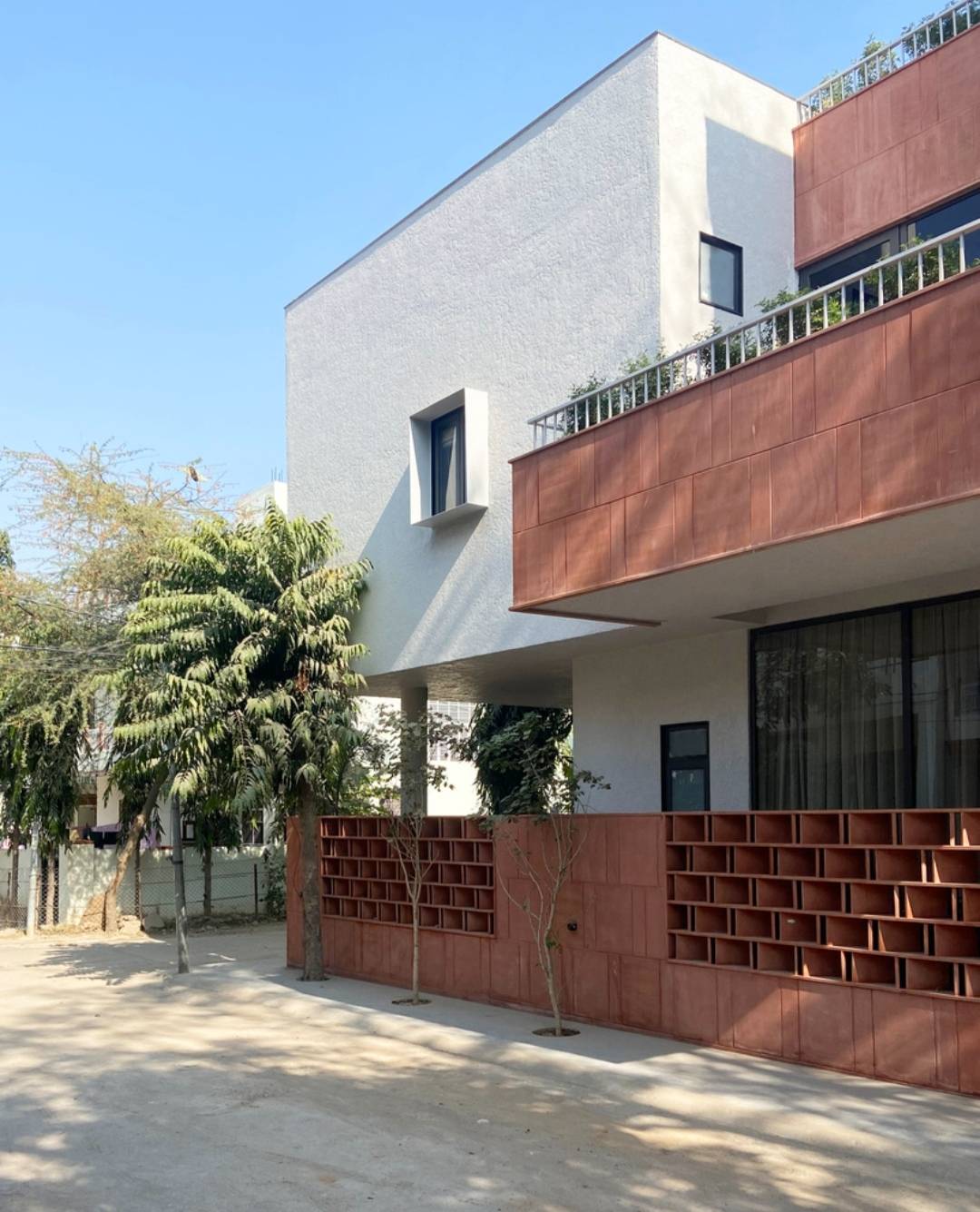A building automation system (BAS), also referred to as a building management system (BMS) or building control system (BCS), is a centralized solution for monitoring and controlling various building systems such as HVAC, lighting, security, and fire alarms. It integrates sensors, controllers, actuators, and software to collect data, analyze it, and make automated adjustments to system operations based on predefined parameters and user-defined schedules. BAS optimizes energy efficiency, reduces operating costs, improves occupant comfort and productivity, enhances security and safety, and enables remote monitoring and control of building systems.
By providing centralized control and automation of building systems, a BAS streamlines facility management, ensures optimal performance of equipment, and promotes sustainability through energy conservation and operational efficiency. It offers building operators real-time insights into system operations, facilitates proactive maintenance, and enables quick response to emergencies, ultimately contributing to a more comfortable, safe, and cost-effective built environment.
Components of Building Automation Systems
A building automation system (BAS) typically consists of several key components:
1. Sensors: These devices detect various environmental parameters such as temperature, humidity, occupancy, and light levels within the building.
2. Controllers: Controllers receive input from sensors, process data, and execute commands to regulate building systems accordingly. They can be programmable logic controllers (PLCs), direct digital controllers (DDCs), or software-based controllers.
3. Actuators: Actuators are responsible for physically adjusting building systems based on commands from the controllers. They control equipment such as valves, dampers, motors, and switches to regulate heating, ventilation, air conditioning (HVAC), lighting, and other systems.
4. Human-Machine Interface (HMI): The HMI provides a user-friendly interface for building operators to monitor system status, view data, adjust setpoints, and configure parameters. It can be a graphical user interface (GUI), web-based dashboard, or mobile application.
5. Communication Network: A communication network connects all components of the BAS, allowing them to exchange data and commands. Common protocols include BACnet, Modbus, LonWorks, and Ethernet/IP.
6. Software: BAS software collects and analyzes data from sensors and controllers, manages system operations, schedules tasks, generates reports, and facilitates remote access and control.
7. Integration Gateway: For buildings with existing legacy systems or equipment from different manufacturers, an integration gateway may be used to interface with diverse protocols and standardize communication across the BAS.
8. Backup Power Supply: To ensure continuous operation and data integrity, BAS components may be equipped with backup power sources such as uninterruptible power supplies (UPS) or emergency generators.

Advantages of Building Automation Systems
1. Energy Efficiency: Building Automation Systems (BAS) employ various strategies to optimize energy usage within a building. This includes controlling heating, ventilation, and air conditioning (HVAC) systems based on occupancy schedules and environmental conditions. By reducing unnecessary energy consumption during unoccupied hours or adjusting setpoints to match occupancy patterns, BAS can achieve significant energy savings, leading to lower utility bills and reduced environmental impact.
2. Improved Comfort and Indoor Air Quality: BAS play a crucial role in maintaining comfortable indoor environments by regulating temperature, humidity, and ventilation levels. By continuously monitoring these parameters and making adjustments in real-time, BAS ensure that occupants remain comfortable throughout the day. Additionally, BAS can monitor indoor air quality metrics such as CO2 levels and particulate matter concentrations, triggering ventilation systems to provide fresh air and remove pollutants, thus promoting better indoor air quality and occupant health.
3. Remote Monitoring and Control: One of the key advantages of BAS is the ability to remotely monitor and control building systems from anywhere with an internet connection. Building managers can access BAS interfaces via web-based dashboards or mobile apps to view system status, adjust setpoints, and troubleshoot issues in real-time. This remote accessibility improves operational efficiency by enabling quicker response times to equipment faults or alarms, reducing the need for onsite visits and manual interventions.
4. Predictive Maintenance: BAS leverage data analytics and machine learning algorithms to predict equipment failures before they occur. By analyzing historical performance data and identifying trends or anomalies, BAS can detect potential issues such as abnormal energy consumption patterns or equipment degradation. This proactive approach to maintenance allows building operators to schedule repairs or replacements in advance, minimizing downtime and avoiding costly emergency repairs.
5. Occupant Comfort Personalization: Advanced BAS solutions offer customizable settings for individual workspaces or zones within a building. Occupants can adjust temperature, lighting, and other environmental parameters according to their preferences using intuitive interfaces or mobile apps. This level of personalization enhances occupant satisfaction and productivity by creating a comfortable and empowering work environment tailored to individual needs.
6. Enhanced Security and Safety: BAS integration with security systems enables comprehensive monitoring and response capabilities to enhance building security and occupant safety. BAS can integrate with access control systems to manage entry permissions and track building access. In case of security breaches or emergencies, BAS can trigger alarms, lock doors, and initiate emergency protocols such as evacuations or notifications to emergency responders, ensuring a swift and coordinated response to critical events.
7. Compliance with Regulations and Standards: BAS help building owners and operators comply with regulatory requirements and sustainability standards related to energy efficiency, environmental performance, and occupant safety. By implementing energy-saving measures such as demand response or peak shaving, BAS demonstrates adherence to building codes, green building certifications, and government mandates, thus avoiding penalties and ensuring legal compliance.
8. Scalability and Flexibility: BAS solutions are designed to be scalable and adaptable to accommodate changing building needs and technological advancements. Whether retrofitting existing buildings or designing new construction projects, BAS can be customized to meet specific requirements and integrate seamlessly with third-party systems. This scalability ensures that BAS investments remain relevant and effective over time, supporting future growth and evolving building management needs.

Types of Building Automation Systems
1. Centralized Control Systems:
Centralized BAS operate through a single control unit or server that manages all building systems from a central location. These systems offer comprehensive control over HVAC (Heating, Ventilation, and Air Conditioning), lighting, security, and other building systems. By consolidating control functions, centralized systems streamline operations and facilitate seamless communication between different systems. They enable centralized programming, scheduling, and data logging, making them ideal for large commercial or institutional buildings with complex operational requirements. With centralized oversight and coordination, these systems enhance operational efficiency and resource management.
2. Decentralized Control Systems:
Decentralized BAS distribute control functions across multiple local controllers or building zones, allowing each controller to operate independently while communicating with a central management system for coordination. These systems are suitable for buildings with diverse usage patterns or spatial configurations, offering flexibility and scalability. Decentralized systems provide localized control and autonomy, enabling customized control strategies for individual areas or systems. They offer advantages such as increased flexibility, scalability, and redundancy, making them ideal for applications where centralized control may not be feasible or practical.
3. Integrated Building Management Systems (BMS):
Integrated BMS consolidate multiple building systems into a unified platform for holistic management and optimization. These systems integrate HVAC, lighting, security, fire safety, and energy management systems to streamline operations and improve efficiency. Integrated systems enable seamless communication and interoperability between disparate systems, enhancing operational efficiency and occupant comfort. They provide a holistic view of building operations and facilitate data-driven decision-making, making them ideal for large-scale commercial buildings or campuses where comprehensive control and coordination are required.
4. Stand-Alone Control Systems:
Stand-alone BAS operate independently without integration with other building systems, typically controlling individual equipment or subsystems such as HVAC units or lighting fixtures. These systems are suitable for small-scale applications or retrofit projects where full integration may not be necessary. Stand-alone systems offer simplicity, cost-effectiveness, and ease of installation, making them suitable for specific equipment control needs. While they lack the centralized control and coordination of integrated systems, stand-alone systems provide localized control and autonomy, enabling targeted control strategies for individual equipment or areas.
5. Web-Based Control Systems:
Web-based BAS utilize web-based interfaces or cloud platforms for remote monitoring and control, allowing users to access system dashboards, analytics, and controls from anywhere with an internet connection. These systems are suitable for remote facility management or distributed building portfolios, offering convenience, accessibility, and scalability. Web-based systems enable real-time monitoring and management of building operations from any location, providing flexibility and mobility for facility managers and operators. By leveraging cloud technology, they offer enhanced connectivity, security, and scalability compared to traditional on-premises systems.
6. Open Protocol Systems:
Open protocol BAS adhere to standardized communication protocols, enabling interoperability with third-party devices and systems. These systems support integration with a wide range of equipment and technologies, promoting flexibility and future-proofing. Open protocol systems are ideal for environments where vendor neutrality and interoperability are priorities, offering flexibility, compatibility, and freedom of choice. By avoiding vendor lock-in and proprietary restrictions, open protocol systems empower building owners to select best-in-class solutions and adapt to evolving technology trends and requirements.
7. Proprietary Control Systems:
Proprietary BAS are designed and manufactured by a single vendor, using proprietary communication protocols and software. These systems offer tight integration and compatibility with proprietary equipment and components, ensuring optimized performance and seamless operation within a closed ecosystem. Proprietary systems are ideal for environments where optimized performance and seamless integration are paramount, providing high reliability, performance, and optimization. While they may lack the flexibility and interoperability of open protocol systems, proprietary systems offer a high level of integration and customization tailored to specific equipment and application requirements.
Applications of Building Automation Systems
Building Automation Systems (BAS) find applications across various sectors and building types, enhancing efficiency, comfort, and safety. Here are some common applications of BAS:
1. Commercial Buildings:
BAS are extensively used in commercial buildings such as office complexes, retail centers, and hotels to optimize energy usage, maintain indoor comfort, and ensure operational efficiency. These systems regulate HVAC, lighting, security, and access control systems, providing centralized control and monitoring for facility managers.
2. Industrial Facilities:
In industrial facilities such as manufacturing plants, warehouses, and data centers, BAS play a crucial role in managing complex systems and processes. They control HVAC and ventilation systems to maintain optimal conditions for equipment and personnel, monitor energy usage, and ensure compliance with safety regulations.
3. Healthcare Facilities:
Hospitals, clinics, and medical centers rely on BAS to maintain strict environmental conditions, including temperature, humidity, and air quality, to support patient care and ensure compliance with regulatory standards. These systems integrate with critical equipment such as HVAC, medical gas, and lighting systems to create a comfortable and safe environment for patients and staff.
4. Educational Institutions:
BAS are deployed in schools, colleges, and universities to control heating, cooling, and lighting systems across campus buildings. These systems help reduce energy consumption, optimize scheduling of HVAC and lighting systems based on occupancy patterns, and enhance indoor air quality to create conducive learning environments.
5. Residential Buildings:
In residential buildings such as apartment complexes and condominiums, BAS provide centralized control and monitoring of HVAC, lighting, and security systems. These systems offer energy-saving features such as programmable thermostats, occupancy sensors, and remote access control, enhancing comfort and convenience for residents while reducing utility costs.
6. Government Facilities:
Government buildings, including administrative offices, courthouses, and military installations, utilize BAS to manage energy consumption, ensure security, and maintain operational efficiency. These systems regulate HVAC and lighting systems based on occupancy schedules, monitor energy usage in real-time, and provide centralized control for facility managers to optimize resource allocation and improve sustainability.
7. Data Centers:
Data centers require precise environmental control to maintain optimal operating conditions for sensitive equipment and ensure uninterrupted operation. BAS monitor temperature, humidity, and air quality within data centers, adjusting HVAC systems and airflow patterns to prevent equipment overheating and minimize energy consumption.

Building Automation System Market Potential & Demand Driving Factors in India
As per, bonafideresearch.com, The Indian building automation system market was valued at approximately USD 1.5 billion in 2020 and is projected to grow at a compound annual growth rate (CAGR) of around 12% over the next five years. This growth is driven by the increasing implementation of smart city projects, rising energy costs, the need for improved energy efficiency, and the growing adoption of IoT and AI technologies in building management.
The demand for building automation systems (BAS) in India is substantial and expanding rapidly, driven by several key factors such as urbanization, energy efficiency needs, smart city initiatives, and technological advancements.
Rapid Urbanization and Smart Cities
India is undergoing one of the fastest rates of urbanization globally, with the urban population expected to reach 600 million by 2031. This rapid urban growth creates significant demand for advanced infrastructure solutions, including building automation systems. The Indian government's Smart Cities Mission, aiming to develop 100 smart cities, plays a pivotal role in this transformation. Smart city projects necessitate the integration of BAS to manage complex infrastructures efficiently, ensuring optimal resource utilization and enhanced living conditions.
Energy Efficiency and Sustainability
Energy consumption in India is high, with buildings accounting for approximately 35% of total energy use. The push for energy efficiency and sustainability is therefore critical. Building automation systems contribute significantly by optimizing energy usage for lighting, HVAC (heating, ventilation, and air conditioning), and other building systems. This not only reduces energy consumption but also operational costs. As India adopts stricter environmental regulations and green building certifications (such as LEED and IGBC), the demand for BAS that support energy-efficient and sustainable operations is expected to grow.
Technological Advancements and IoT Integration
Technological advancements, particularly in IoT (Internet of Things), AI (artificial intelligence), and ML (machine learning), are transforming the BAS market. IoT-enabled BAS allow for real-time monitoring and control of building functions, leading to enhanced operational efficiency and occupant comfort. AI and ML integration enable predictive maintenance, advanced analytics, and automated decision-making, further driving the market growth. The global trend towards smart buildings and the digital transformation of infrastructure are reflected in the Indian market as well.
Commercial and Residential Sector Growth
The commercial sector, including offices, retail spaces, and hotels, is a major market for building automation systems in India. Commercial buildings require sophisticated systems to manage energy consumption, security, and occupant comfort efficiently. The residential sector is also seeing increased adoption of BAS, driven by rising disposable incomes, changing lifestyles, and a growing awareness of smart home technologies. High-end residential projects often include advanced BAS for energy management, security, and convenience.
Conclusion
Building Automation Systems (BAS) represent a critical advancement in modern building management, offering comprehensive control and monitoring capabilities across various sectors and building types. By integrating and automating HVAC, lighting, security, and other building systems, BAS enhances energy efficiency, occupant comfort, and operational performance while reducing costs and environmental impact. From commercial buildings and industrial facilities to healthcare institutions and residential complexes, BAS play a vital role in optimizing building operations, improving sustainability, and ensuring compliance with regulatory standards. As technology continues to evolve, the future of BAS holds even greater promise, with advancements in data analytics, artificial intelligence, and IoT connectivity poised to further enhance the capabilities and effectiveness of building automation. With their ability to create smarter, more efficient, and sustainable built environments, BAS are set to remain indispensable tools for building owners, facility managers, and occupants alike in the years to come.









.png)